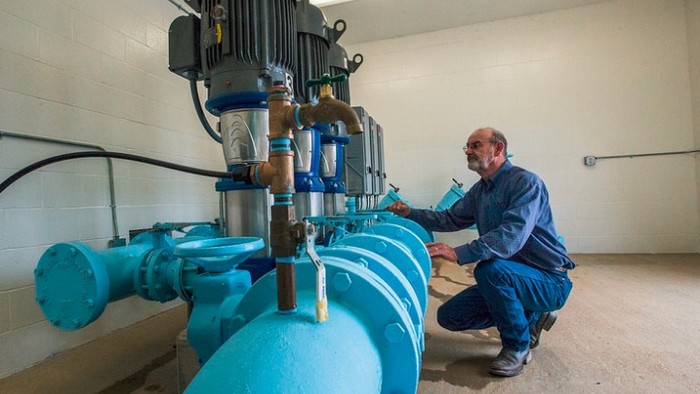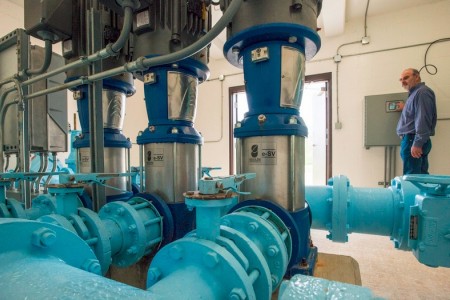Conservation Partnerships with Water Utilities

Eve Boyce and Marcy Lyman
This explainer is available in PDF format for non-commercial Creative Commons uses if it is shared with attribution and without remixing. We welcome your feedback. We encourage you to contact us if you decide to share it with a group.
In the mid-1990s, New York City was faced with the daunting prospect of investing $6 billion to construct a new water-treatment facility to meet United States Environmental Protection Agency (EPA) Clean Water Act requirements.
On top of the initial construction costs, this project was going to cost the city an estimated $250 million annually in maintenance.
Rather than take on the considerable costs of treatment, New York City opted to dedicate around $1.5 billion to the protection of the lands within the watershed of its reservoir system. The idea was that these protected lands would provide ecological services that would filter water running into the system and maintain the high water quality, thus removing the need for future treatment.
20 years later, New York City has saved billions of dollars, conserved over 25,000 acres of land, and preserved the filtration waiver it receives from EPA’s Safe Drinking Water requirement to treat drinking water (Kenny, 2006).
Why Watershed Management Conserves Money
Most water systems in the United States are not able to obtain a water-treatment waiver from the EPA due to the existing conditions of their watersheds, but they could still benefit from cost savings associated with better watershed management.
Many water utilities are seeing increased costs associated with the treatment of drinking water and are looking for alternative strategies to avoid raising rates.
Practices like decreasing agricultural runoff, increasing watershed forest cover, and preventing increased impervious surfaces have the potential to deliver cost savings to utilities through avoided filtration and treatment costs.
Land-conservation organizations and water-utility companies are recognizing their shared interest in protecting watershed ecosystems.
In an increasing number of communities across the country, utilities are working with conservation groups to ensure the ecosystem services provided by healthy watersheds are protected and maintained.
This strategy doesn’t simply provide cost savings to water companies. It can also create a new source of funding and constituencies for land conservation.
How Source Water Protection Works
Investments in land conservation for source water protection vary across landscapes and regions. They also vary among conservation organizations and water providers.
-
Some water providers have a history of conserving land within their watersheds and choose to invest in conservation easements or outright purchases of lands in their watersheds.
-
Others may see the value of land conservation but may not want to be in the land-conservation business. They will, however, support landowners or invest in organizations that promote best management practices. Or they may work with conservation organizations to identify and complete projects.
-
Others may own land within their watersheds but do not have it permanently conserved. They may not know that the land is an asset with conservation value that can leverage funds to purchase or conserve additional lands.
-
Finally, there are others that have no experience with or interest in the role of land conservation as a strategy to manage water quality and supplies. This category is shrinking rapidly.
In each case, there are opportunities and value that partnerships with conservation organizations can provide. These can include initial information on the benefits of conserving and managing land as a strategy to protect water supplies. They can also include identifying projects, working with landowners, conducting transactions, and raising funds.
At the same time, water utilities often have valuable information about water-quality and land-use practices in their watersheds. They are also familiar with the priority lands they have identified for protection. They have financial data important to developing funding strategies. They also have the ability to fund conservation projects through rate structures.
How to Get Started
The first step is to identify the water utilities in your region and make a connection with one or more of their staff and/or board members. This gives nonprofits an opportunity to learn what water quality or supply issues utilities are facing. They can also assess what kinds of ecological investments would be most appropriate for the watersheds. In addition, they can explore the interest and willingness of the utilities to consider conservation investments.
It is important to note that water utilities may not be the only entities interested in this type of project. Other municipal entities such as sewage management departments may also provide partnership opportunities.
It is also a chance to provide information on the many resources available on the topic and examples of successful partnership projects. These conversations will help determine the utilities’ receptivity to the idea of investments in land conservation. They will also show the type of information the utilities may need to inform their decisions.
Some utilities may be assured simply by the outcomes of other projects in your region. Others may require significantly more analysis on priority lands, costs and benefits.
Organizations such as The Nature Conservancy and World Resources Institute can help model environmental outcomes if needed.
What Some Common Challenges Are
As with any new partnership, some of the initial challenges are related to the culture, language and priorities of the organizations involved with the partnership.
Land trusts and conservation organizations have very different capacities, experience and staffing from water utilities.
Taking the time to develop relationships between the organizations to develop a common language, identify shared interests, and design a common strategy will ensure a productive partnership.
Other challenges include the organizational capacity needed to identify and complete land conservation projects at a scale that can demonstrate positive outcomes for water quality and supplies.
This may include working with many landowners, packaging multiple transactions, and securing and leveraging various funds. For smaller land trusts, working at scale may require adding new capacity. Water utilities have significant infrastructure needs. They may see contributing to land conservation as a luxury they can’t afford.
Generally, challenges related to robust cost-benefit analysis have emerged because the science of watershed dynamics that affect performance, the analysis of what impacts individual land-conservation projects will have on water quality or supplies, and the data on benefits to water utilities due to avoided costs of treatment are not yet robust enough to make definitive cost-benefit analyses. This is particularly challenging if investment decisions require such an analysis.
Modeling programs are being developed to assist with this analysis. These include Natural Capital Project’s InVEST or the Chesapeake Conservancy’s Conservation Innovation Center’s High Resolution Data Programs (Chesapeake Conservancy, 2018; Natural Capital Project, 2018).
How Case Studies Demonstrate New Approaches
There are a growing number of new partnerships between water utilities and conservation organizations that illustrate a variety of financing strategies for investing in land conservation.
The two cases below represent a growing recognition of the value of multiple partners as well as innovative and complex financing strategies. While these cases are both located on the East Coast, there are watershed investment projects happening across the United States.
Portland Water District (PWD) in the city of Portland, Maine has received a filtration waiver from the EPA due to the water quality of its source water, Sebago Lake. Currently, 10 percent of the Sebago Lake watershed lands (24,000 acres) are protected.
PWD has developed a 20-year watershed investment plan. It has identified and designated priority lands for conservation. It has also partnered with local, regional and national conservation groups.
This partnership, called Sebago Clean Waters, aims to collaborate to conserve 25 percent of the lands within the watershed, more than double the amount currently conserved.
Sebago Clean Waters partners estimate it could cost an estimated $12-36 million to achieve 15-25 percent watershed protection.
For its land protection grants to land trusts, PWD has been contributing up to 25 percent of the cost of conservation acquisition or easements brought forward by the land trust partners.
To date, PWD has invested $500,000, which leveraged an additional $5 million in outside funding for land acquisition and conservation easements. They envision contributing as much as $6 million in support of the 20-year watershed investment plan (S. Meyer, personal communication, April 12, 2018.)
Manchester Water Works (MWW) in Manchester, N.H. has been working with the Society for the Protection of New Hampshire Forests (SPNHF) to sell a conservation easement on 1,870 acres in the upper watershed of its water supply, Lake Massabesic.
The easement’s total cost was initially $2.3 million. MWW donated a portion of the value of the easement, bringing the total cost down to $1.9 million.
Over $1.6 million was raised through the state’s Land Conservation Investment Program (LCHIP) and the NH Department of Environmental Service’s Water Supply Land Protection Grant Program and the Aquatic Resources Mitigation Fund.
The remaining funds been raised by the SPNHF through private fundraising. The revenue raised through the sale of the easement will be used by the MWW to acquire other lands within the watershed identified as priority lands to protect the quality of the water supply (Society for the Protection of New Hampshire Forests, 2017).
How Innovations Are Being Tested in the Field
There are some innovations in this field that are currently being tested and are worth noting.
State Revolving Funds and the Sponsorship Program: All states in the nation have Clean Water State Revolving Fund and Drinking Water State Revolving Fund programs. These combine federal grants with state contributions that offer loans and/or grants to support the construction and maintenance of “hard” infrastructure to comply with the goals of the federal Clean Water Act and the Safe Drinking Water Act. Hard infrastructure can include equipment such as water pipes, processing facilities, and treatment plants.
Most states have provisions for the use of either or both the Clean Water State Revolving Fund and the Drinking Water State Revolving Fund for land-conservation projects, particularly those that relate to source-water protection.
More recently, however, some states, most notably Ohio and Iowa, have developed an additional program called a Sponsorship Program that pairs a land-conservation project or best management practice with a traditional “hard infrastructure” project. By lowering the interest rate for the State Revolving Fund loan, this generates funds that can be used as a grant for the land-conservation project.
DC Water Green Infrastructure Project: The impact investment advisory firm Quantified Ventures has partnered with the Washington, DC water utility to develop a “pay-for-success” environmental impact bond.
The returns for investors in the $25-million bond are tied to the performance of green infrastructure in preventing sewage overflow into the Chesapeake Bay.
Pay-for-success impact bonds may be replicable in the drinking-water-protection space.
References
Kenny, A. (2006). Ecosystem services in the New York City watershed. Ecosystem Marketplace. Retrieved from https://www.forest-trends.org/ecosystem_marketplace/ecosystem-services-in-the-new-york-city-watershed-1969-12-31-2/
Chesapeake Conservancy. (2018). High resolution data program. Retrieved from http://chesapeakeconservancy.org/conservation-innovation-center/high-resolution-data/
Natural Capital Project. (2018). InVEST. Retrieved from https://www.naturalcapitalproject.org/invest/
Society for the Protection of New Hampshire Forests. (2016.) Effort to protect Manchester’s drinking water source wins LCHIP grant. Retrieved from https://forestsociety.org/press-release/effort-protect-manchester’s-drinking-water-source-wins-lchip-grant
Society for the Protection of New Hampshire Forests. (2017.) Protecting our drinking water: Manchester Water Works project. Retrieved from https://forestsociety.org/project/protecting-our-drinking-water-manchester-water-works-project.
Note: Our expert coauthors volunteer their time to assist our writers with these pieces.
To comment on this article, please post in our LinkedIn group, contact us on Twitter, or email the author via our contact form.

